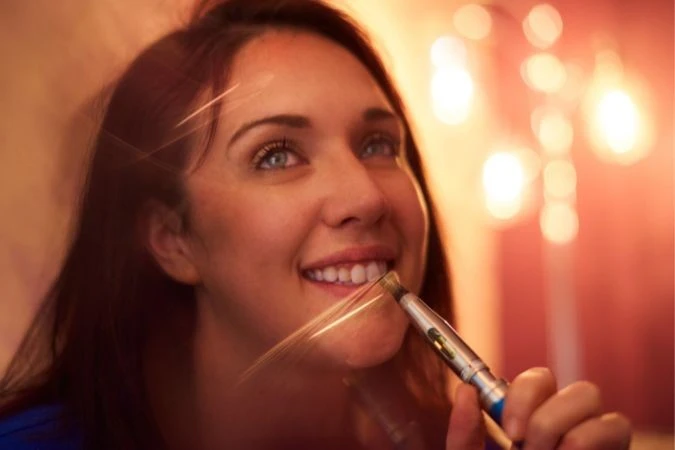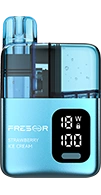How to Vape for the First Time: Do's and Don'ts

4 May 2024

Vaping is the process where an individual uses an electronic cigarette (e-cigarette) or vape pen to inhale vapor, which often contains nicotine and flavorings. The act of vaping has emerged as a popular alternative to traditional cigarette smoking, attracting a diverse audience looking to experience its various flavors and potential smoking cessation benefits.
But there's a question that beginners often ask. How to vape for the first time?
Let's find the answer.
Different Types of Vaping Devices
Before you take your first puff, it's crucial to understand the main types of vaping devices out there. Each kind is designed for various tastes and experiences.
Disposable vs. Reusable
Disposable vapes are single-use devices with prefilled e-liquid. Once the battery or e-liquid runs out, they are discarded.
Reusable devices , on the other hand, often referred to as 'vape pens' and 'mods,' can be refilled with e-liquid. They came up with a rechargeable battery. They require initial setup and maintenance but offer more flexibility and sustainability.
Vape Pen vs. Vape Mod vs. Vape Pods
Vape pens are cylindrical devices that are simple, lightweight, and user-friendly, making them excellent for beginners.
Vape Mods are bulkier and more powerful vape kits, usually with adjustable settings catering to seasoned vapers.
Pod systems are the more recent addition, with a similar concept to disposable e-cigarettes but with interchangeable pods that are replaced when necessary.
Essential Components of a Vape

A vaping device is made up of several components, including:
Battery
The battery powers the vape device. It's the heart of the system, providing the necessary energy to heat the e-liquid into vapor. Most starter kits have rechargeable batteries, but disposables come with a pre-charged one.
Atomizer
The atomizer houses the heating element. When activated, it heats the e-liquid to create vapor. It's essential for turning liquid into an inhalable mist.
E-liquid
E-liquid, often referred to as vape juice, is pivotal to the vaping experience. It contains flavorings, nicotine, and a base of propylene glycol (PG) or vegetable glycerin (VG). The combination determines the taste and cloud production.
Tank or Pod
This component holds the e-liquid. In traditional setups, it's called a tank. Pod MOD systems use pods, which are compact e-liquid cartridges. Tanks are refillable, while a pod vape can be either refillable or disposable.
Coil
The coil is a wire found within the atomizer that coils around the wicking material soaked in e-liquid. When heated, it vaporizes the liquid on the wick.
Mouthpiece
The part of the vape you breathe from is called the mouthpiece, or drip tip. It sits on top of the device and is where you and your vape connect the last step before inhaling the vapor.
How to Get Started with Vaping?

To start vaping, there are some simple steps you need to follow that will ensure a smooth transition from smoking to vaping. Here's a simple guide to help you begin your vaping journey:
Choosing Your First Vape Device
The first step in vaping is selecting the suitable device for you. There are three main types of vape devices catered to beginners:
Pod Vapes
Pod vapes are compact and often the most straightforward to use. They come with prefilled prefilled or refillable 'pods' and typically have a draw-activated mechanism, making them very similar to smoking a regular cigarette. These are perfect for those looking for a hassle-free transition into vaping.
Vape Pens
Vape pens are the next step up in terms of size and battery life. They have a cylindrical shape with a tank to hold the e-liquid and a rechargeable battery. Vape pens are slightly more customizable than pod vapes, with refillable tanks and the ability to change the coil.
Box Mods
Box mods are larger devices with more features, such as adjustable power outputs. They offer better control over the vaping experience but come with a steeper learning curve and are usually reserved for more experienced vapers.
When choosing your first vape kit, consider factors like:
Ease of use: A beginner-friendly device should be easy to assemble and operate.
Portability: Think about how you'll carry your vape. If you're always on the go, a smaller device is probably best.
Battery life: You don't want your device to run out of battery when you need it, so consider how often you'll be able to recharge.
Selecting Your Vape Juice
Your e-juice, or e-liquid, is what you'll be inhaling, so it's crucial to understand what you're getting. Several elements play into what makes an e-juice right for you:
PG vs. VG E-Liquids
Propylene Glycol (PG) and Vegetable Glycerin (VG) are the two primary base components of e-liquids. PG is known for better flavor retention and providing a throat hit similar to smoking. VG is thicker and produces more vapor, which can be smoother on the throat.
Most e-liquids are a blend of the two, with the ratio affecting the vaping experience. A mix with more PG (50/50 or 60/40 PG/VG) is commonly recommended for beginners.
Nicotine Strength
The amount of nicotine in vape liquid is expressed in terms of milligrams per milliliter, abbreviated as mg/mL. For beginners, it's generally advised to start with a lower concentration of nicotine, between 3mg/mL and 12mg/mL, depending on your smoking habits. A heavier smoker may require a higher nicotine strength to satisfy their cravings.
Flavor
The world of vape flavors is vast, ranging from tobacco and menthol to exotic fruit and dessert flavors. When choosing a starter kit, it's beneficial to experiment with different flavors to find what you like. Remember, taste is subjective, so don't be discouraged if something widely loved doesn't suit your palate.
Preparing Your Vape Device for the First Use
Once you have your device and e-liquid, you need to get everything ready for your first vape:
Charging
If you have a rechargeable device, make sure it's fully charged before your first use. The last thing you want is for your battery to die mid-vape.
Filling the Tank
For vape pens or box mods with tanks, you'll need to fill the tank with e-liquid. Be careful not to overfill; leave a small amount of air at the top to allow for proper wicking.
Priming the Coil
The coil is the component that heats the e-liquid into vapor. Before you take your first puff, it's essential to prime the coil by letting the e-liquid soak into the wicking material for a few minutes. This helps prevent a dry hit—a nasty, burnt-tasting puff that can ruin your coil.
How to Inhale?
Learning how to inhale vapor correctly can greatly affect your experience:
Mouth-to-Lung (MTL)
MTL vape devices involve a technique that is similar to smoking traditional cigarettes. First, inhale the vapor into your mouth, and then take a second breath to inhale it into your lungs.
Direct-to-Lung (DTL)
This method is more like breathing in through a straw. Inhale the vapor directly into your lungs in one big breath. DTL is familiar with higher-power devices that produce more vapor.
Whichever method you choose, it's helpful to start with short inhales to vape safely and to get used to the vapor and the effect of nicotine or flavors.
How to Use a Vape for the First Time?

Now that your vape is primed, it's time to take your first puff. Keep these steps in mind when vaping for the first time.
Charging Your Device
Different devices have different charging methods. Always use the charger that comes with your device to prevent damage or battery hazards.
Filling Your Tank or Pod with E-Liquid
Take care not to overfill – consult your device's manual for the recommended level.
Waiting for the Wick to Saturate
To protect the coil, the wick needs to be fully saturated before you use the device.
Turning On the Device
Each device has a different way to turn it on, typically 5-presses of the power button. Ensure it's ready before taking a puff.
Inhaling Techniques: Mouth-to-Lung vs. Direct-Lun g
Mimic your style to your puffing technique – former smokers might start with mouth-to-lung vaping.
Adjusting Your Vape Settings for Optimal Use
If you have a device with adjustable settings, start with the manufacturer's recommendations and slowly adjust to your preference .
The Do's of Vaping
Certain practices can enhance your vaping experience.
Starting with Low or Zero Nicotine : To avoid unwanted side effects from too much nicotine.
Proper Inhalation Techniques : Ensuring you get the most out of the flavor and vapor without straining your throat.
Cleaning and Maintaining Your Device : A clean device ensures better performance and a longer lifespan.
The Don'ts of Vaping
Conversely, certain habits can hinder your vaping experience or even be dangerous.
Avoiding High Nicotine Content Initially : Until you are more accustomed to vaping, high nicotine levels can be overwhelming.
Overfilling the Tank : This can lead to flooding and spit back, making your vape experience uncomfortable.
Inhaling too sharply or Frequently can cause coughing and discomfort, especially if you're not used to inhaling vapor.
FAQs
Below are typical questions beginners might ask:
What's the minimum age for vaping?
The legal vaping age varies by region, but in many places, you must be at least 18 years old to vape legally. Always follow local regulations. It's essential.
How to Inhale a Vape Properly?
Take a slow, gentle draw into your mouth, then inhale the vapor into your lungs. The length of time you hold the vapor in your mouth depends on the device and your preference.
How much do vapes cost?
Vape costs can vary significantly. Disposable vapes are generally cheaper, but reusable devices offer more long-term value. Research and decide on a budget that fits your needs.
Are disposable vapes safe?
When used as intended, disposable vapes can be a safe option for vaping. It's crucial to purchase from reputable sources and not modify the device in a way it wasn't designed for.
Does vaping help you quit smoking cigarettes?
Vaping has been a valuable tool for many people inhaling cigarette smoke. However, it's not a one-size-fits-all solution. Combining vaping with other cessation methods and support groups can provide the best chances for quitting smoking.

























